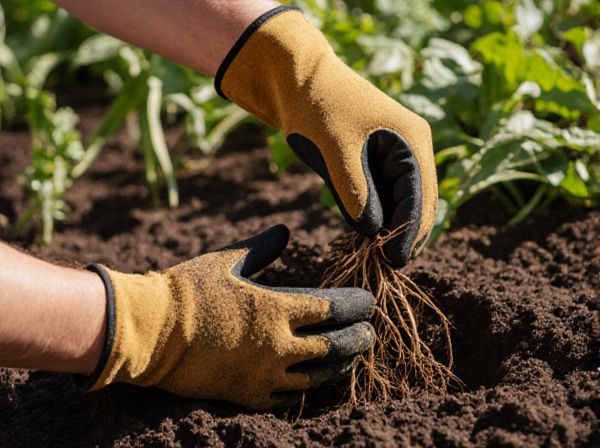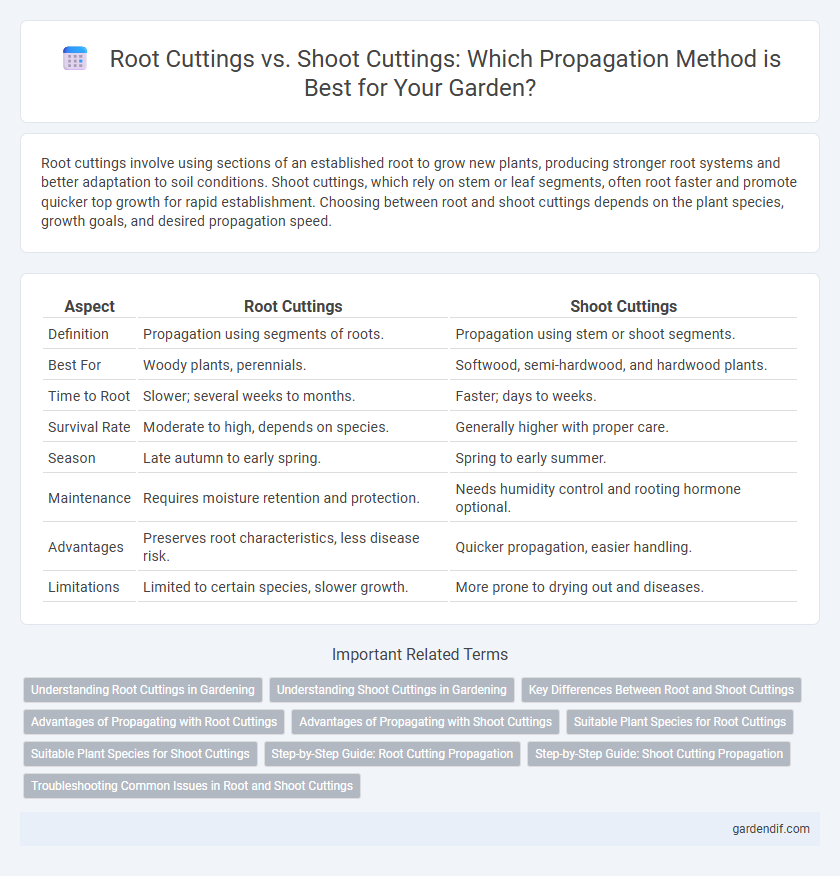
Root cuttings vs Shoot cuttings Illustration
Root cuttings involve using sections of an established root to grow new plants, producing stronger root systems and better adaptation to soil conditions. Shoot cuttings, which rely on stem or leaf segments, often root faster and promote quicker top growth for rapid establishment. Choosing between root and shoot cuttings depends on the plant species, growth goals, and desired propagation speed.
Table of Comparison
| Aspect | Root Cuttings | Shoot Cuttings |
|---|---|---|
| Definition | Propagation using segments of roots. | Propagation using stem or shoot segments. |
| Best For | Woody plants, perennials. | Softwood, semi-hardwood, and hardwood plants. |
| Time to Root | Slower; several weeks to months. | Faster; days to weeks. |
| Survival Rate | Moderate to high, depends on species. | Generally higher with proper care. |
| Season | Late autumn to early spring. | Spring to early summer. |
| Maintenance | Requires moisture retention and protection. | Needs humidity control and rooting hormone optional. |
| Advantages | Preserves root characteristics, less disease risk. | Quicker propagation, easier handling. |
| Limitations | Limited to certain species, slower growth. | More prone to drying out and diseases. |
Understanding Root Cuttings in Gardening
Understanding root cuttings in gardening involves selecting healthy roots from perennial plants, ensuring they are thick and disease-free for successful propagation. Root cuttings generally require a dormant season for optimal growth, where roots are cut into sections and planted horizontally in well-drained soil with consistent moisture. This propagation method produces new plants genetically identical to the parent, ideal for preserving plant traits and expanding garden stock efficiently.
Understanding Shoot Cuttings in Gardening
Shoot cuttings, a common propagation method in gardening, involve using a portion of the stem with leaves to develop new roots and grow into a full plant. This technique is effective for many herbaceous and woody plants, as shoots contain active growth tissues and auxins that stimulate root formation. Compared to root cuttings, shoot cuttings offer quicker establishment and higher chances of maintaining the genetic characteristics of the parent plant.
Key Differences Between Root and Shoot Cuttings
Root cuttings involve using segments of roots to grow new plants, typically producing stronger root systems and better establishment in soil compared to shoot cuttings. Shoot cuttings use stem or branch sections, often containing nodes, to regenerate shoots and leaves, leading to faster initial growth but potentially weaker root development. The choice between root and shoot cuttings depends on plant species, propagation goals, and desired growth speed.
Advantages of Propagating with Root Cuttings
Root cuttings enable the propagation of plants with a higher success rate due to their inherent nutrient reserves and established root systems, promoting faster and stronger new growth compared to shoot cuttings. They are particularly advantageous for species that root poorly from shoots, providing a reliable method to maintain genetic consistency and vigor. Propagating with root cuttings also minimizes the risk of disease transmission and reduces water stress, resulting in healthier and more resilient plant progeny.
Advantages of Propagating with Shoot Cuttings
Propagating with shoot cuttings offers rapid plant development and higher survival rates due to their active growth points and nutrient reserves. Shoot cuttings also enable the cloning of mature plant traits, ensuring uniformity in fruiting and flowering characteristics. This method requires less time to establish compared to root cuttings, making it efficient for commercial propagation of species like roses and grapes.
Suitable Plant Species for Root Cuttings
Root cuttings are particularly suitable for plants with well-developed root systems such as horseradish (Armoracia rusticana), blackberry (Rubus fruticosus), and horseradish family members, allowing efficient propagation from underground parts. These species regenerate vigorously from root segments, producing genetically identical and disease-free offspring. Root cuttings are ideal for woody plants, perennial herbs, and certain shrubs where shoot cuttings may be less effective or slower to root.
Suitable Plant Species for Shoot Cuttings
Shoot cuttings are especially suitable for propagating woody plants such as roses, hibiscus, and Ficus species, as well as many herbaceous plants like coleus and geraniums. These cuttings root quickly and maintain genetic fidelity, making them ideal for ornamental shrubs and indoor houseplants. Propagation success with shoot cuttings largely depends on choosing species with soft or semi-hardwood stems that readily produce adventitious roots.
Step-by-Step Guide: Root Cutting Propagation
Begin root cutting propagation by selecting healthy, mature roots from a parent plant, typically during the dormant season when nutrient reserves are highest. Cut 2-4 inch segments of the root, ensuring each piece has a clean, angled cut to promote new growth, then plant them in a sterile, well-draining propagation medium like a mix of sand and peat. Maintain consistent moisture and warmth around 18-24degC (65-75degF), and expect root cuttings to develop shoots within 4-6 weeks, suitable for propagating woody plants like blackcurrants and horseradish.
Step-by-Step Guide: Shoot Cutting Propagation
Shoot cutting propagation involves selecting a healthy, non-flowering stem and cutting a 4-6 inch section just below a node. Remove lower leaves, dip the cut end in rooting hormone, then plant it in a moist, well-draining medium such as a mix of perlite and peat moss. Maintain high humidity and indirect light until roots develop in 2-4 weeks, ensuring successful propagation.
Troubleshooting Common Issues in Root and Shoot Cuttings
Root cuttings often face issues such as rot and fungal infections due to excessive moisture and poor drainage, requiring well-drained soil and careful watering to prevent decay. Shoot cuttings commonly suffer from wilting and failure to root, often caused by insufficient humidity, inadequate light, or improper cutting techniques that damage growth tissues. Ensuring optimal environmental conditions and using clean, sharp tools significantly improves success rates in both root and shoot cutting propagation.
Root cuttings vs Shoot cuttings Infographic

 gardendif.com
gardendif.com